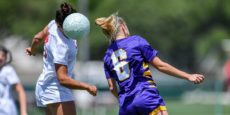

The following is excerpted from an online article posted by ScienceDaily.
New research being presented this week at the annual meeting of the Radiological Society of North America (RSNA) links soccer heading — where players hit the ball with their head — to a measurable decline in the microstructure and function of the brain over a two-year period.
“There is enormous worldwide concern for brain injury in general and in the potential for soccer heading to cause long-term adverse brain effects in particular,” said senior author Michael L. Lipton, M.D., Ph.D., professor of radiology at Columbia University’s Vagelos College of Physicians and Surgeons and affiliate professor of biomedical engineering at Columbia University.
“A large part of this concern relates to the potential for changes in young adulthood to confer risk for neurodegeneration and dementia later in life.”
While previous research has examined adverse effects on the brain related to soccer heading at a single point in time, this new study looked at brain changes over two years.
The study included 148 young adult amateur soccer players (mean age 27, 26% women). The research team developed a specialized questionnaire for players to determine how often they hit the soccer ball with their heads.
The players were assessed for verbal learning and memory and underwent diffusion tensor imaging (DTI), an MRI technique, at the time of enrollment and two years later.
Compared to the baseline test results, the high-heading group (over 1,500 headers in two years) demonstrated an increase of diffusivity in frontal white matter regions and a decrease of orientation dispersion index (a measure of brain organization) in certain brain regions after two years of heading exposure.
“Our analysis found that high levels of heading over the two-year period were associated with changes in brain microstructure similar to findings seen in mild traumatic brain injuries,” Dr. Lipton said.
“High levels of heading were also associated with a decline in verbal learning performance. This is the first study to show a change of brain structure over the long term related to sub-concussive head impacts in soccer.”
Source: ScienceDaily
https://www.sciencedaily.com/releases/2023/11/231129112526.htm
Source: Home Word






